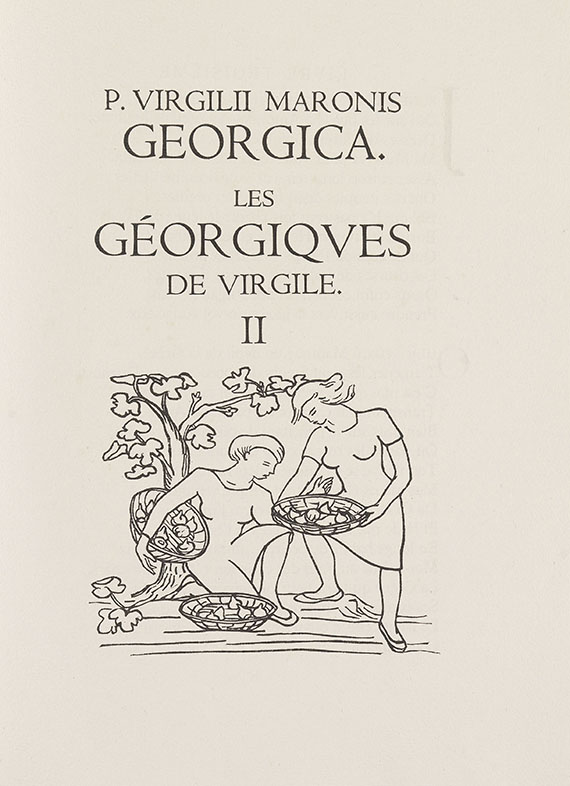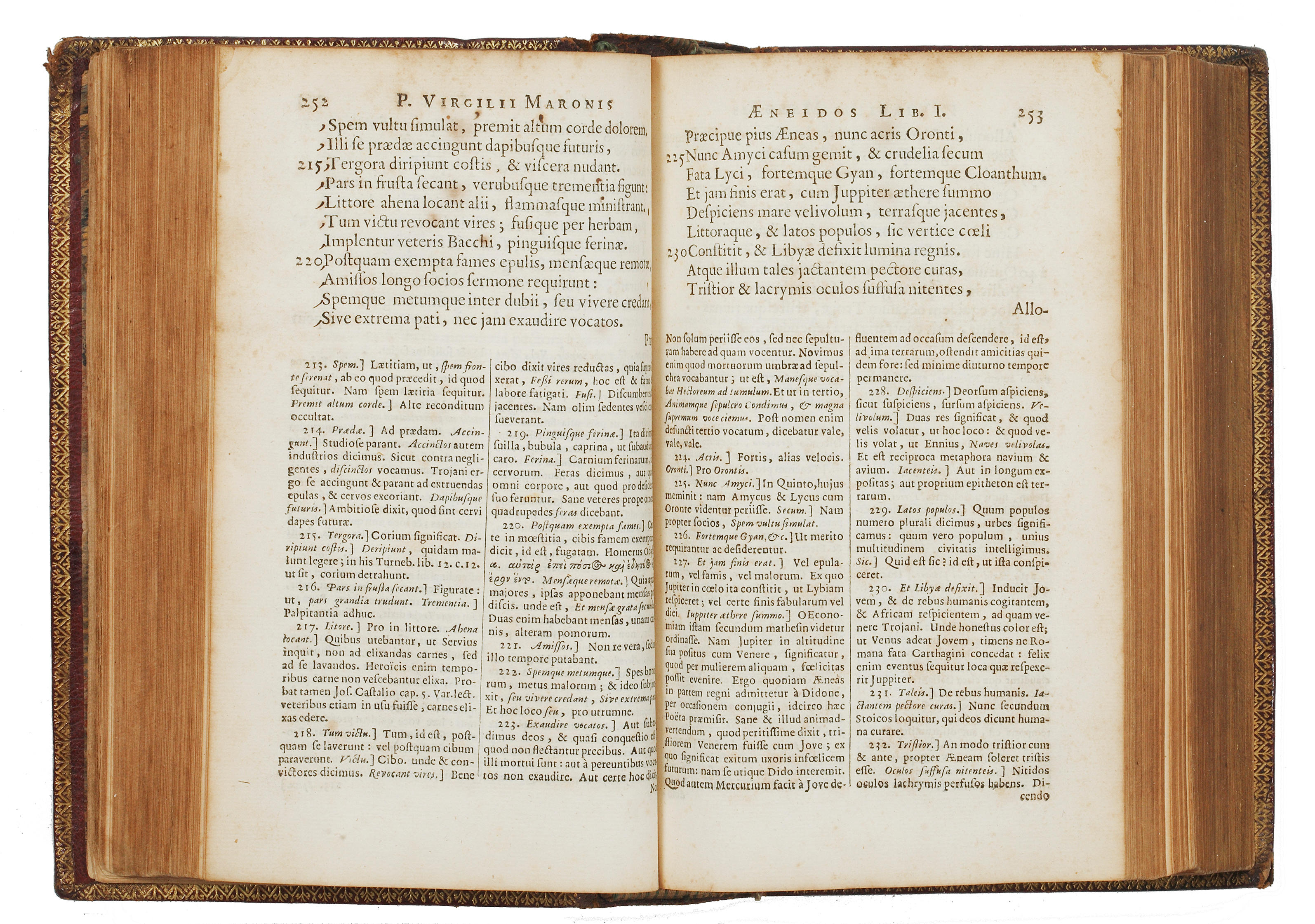Publius VERGILIUS MARO. Eclogues, Georgics, Aeneid . Manuscrit écrit par l'humaniste Uberto Decembrio, Milan 1417, et enluminé par Tomasino da Vimercate, maître d'Heures de Modène. Cet oeuvre précieux fut saisi de Joseph Bonaparte en Espagne lorsqu'il battit en retraite de Vitoria le 21 Juin 1813; le jour suivant il fut présenté a Wellington. brio and illuminated by Tomasino da Vimercate, Master of the Modena Hours, ILLUMINATED MANUSCRIPT ON VELLUM Milan, 1417 335 x 230mm. i+184+i leaves: 1-23 8 , COMPLETE, catchwords in the inner corner of the lower margin of the final verso of each gathering, signature marks or parts of signature marks on the first folios of most gatherings, 40 lines written in a small round gothic bookhand in black ink on a ruling of 3 scored vertical lines and 41 horizontal lines in pale ink, the initial letter of each line against the first vertical and the rest of the word beginning against the second, justification: 205 x 106mm, paragraph marks, rubrics and marginal titles in Bucolica in red, TWENTY-SEVEN ILLUMINATED INITIALS 3 lines high with staves of pink, blue or green against grounds of burnished gold and with infills and marginal sprays of orange, green, pink and blue foliage with white pen-work detailing, SEVENTEEN LARGE HISTORIATED INITIALS accompanied by marginal sprays or, at the major text openings, three-sided borders made up of baguettes of burnished gold, pink and blue with white decoration from which spring foliage sprays of two types, either an imitation of French ivy-leaf rinceaux or scrolling tendrils of pink and blue with wheat-ear terminals and flowers and leaves of pink, blue, orange, red and green, diagram of the zones of heaven (small pigment losses from the foliage of the miniatures on ff.1 and 12v, partial erasure of the arms and slight thumbing to the margin of f.1). Early 19th-century Spanish royal binding of mottled calf, spine gilt with red morocco lettering piece (some small abrasions). THIS IMPORTANT MANUSCRIPT PERFECTLY EXEMPLIFIES EARLY RENAISSANCE COURT HUMANISM, COMBINING SCHOLARLY INTEREST IN CLASSICAL ANTIQUITY WITH A TASTE FOR THE ELEGANT AND COURTLY IN MINIATURE PAINTING. PROVENANCE: 1. The partially erased arms in the lower border of f.1 appear to have been of red and gold with a displayed eagle in chief; these may have been the arms of Giovanni Ferruffini - gules a band or , on a chief of the last a displayed eagle sable . Ferruffini was a judge and a counsellor to the Duke of Milan, Filippo Maria Visconti. Two other manuscripts bear his coats of arms: a Homilies of Basil the Great in Greek, Oxford, Bodl. Lib. Auct.T.4.16, and a 13th-century French copy of the glossed Epistles of St Paul (Paris, Bib. Nat. lat. 665) that was item 564 of the 1426 inventory of the Visconti library in Pavia. The border of trees with perching birds and the arms and monogram of Ferruffini that was added to the opening folio of the Pauline Epistles is also in the style of Tomasino da Vimercate; it seems most likely that after having had this illumination added to the Epistles , Ferruffini presented the manuscript to Filippo Maria Visconti. It was for Filippo Maria that the 1426 inventory of the library at Pavia was compiled . Ferruffini's scholarly interest in classical literature and his humanist contacts are well documented; he was a friend of Francesco Filelfo, and in 1432 Panormita entrusted him to deliver some gatherings of his commentary on Plautus. Whether or not the present manuscript was made for Ferruffini it is likely to have remained in Milan until at least the middle of the 15th century for many of the marginal corrections are made in a Milanese humanistic hand of that date. 2. Colegio Mayor de San Bartolomé, Salamanca. Ownership inscription and shelfmark 194 on opening folio; a note on the rear flyleaf, Todas las obras de lo Vergilio in a late 15th- or early 16th-century hand indicates the manuscript's early arrival in Spain, and it was recorded as item 194 in an i
Publius VERGILIUS MARO. Eclogues, Georgics, Aeneid . Manuscrit écrit par l'humaniste Uberto Decembrio, Milan 1417, et enluminé par Tomasino da Vimercate, maître d'Heures de Modène. Cet oeuvre précieux fut saisi de Joseph Bonaparte en Espagne lorsqu'il battit en retraite de Vitoria le 21 Juin 1813; le jour suivant il fut présenté a Wellington. brio and illuminated by Tomasino da Vimercate, Master of the Modena Hours, ILLUMINATED MANUSCRIPT ON VELLUM Milan, 1417 335 x 230mm. i+184+i leaves: 1-23 8 , COMPLETE, catchwords in the inner corner of the lower margin of the final verso of each gathering, signature marks or parts of signature marks on the first folios of most gatherings, 40 lines written in a small round gothic bookhand in black ink on a ruling of 3 scored vertical lines and 41 horizontal lines in pale ink, the initial letter of each line against the first vertical and the rest of the word beginning against the second, justification: 205 x 106mm, paragraph marks, rubrics and marginal titles in Bucolica in red, TWENTY-SEVEN ILLUMINATED INITIALS 3 lines high with staves of pink, blue or green against grounds of burnished gold and with infills and marginal sprays of orange, green, pink and blue foliage with white pen-work detailing, SEVENTEEN LARGE HISTORIATED INITIALS accompanied by marginal sprays or, at the major text openings, three-sided borders made up of baguettes of burnished gold, pink and blue with white decoration from which spring foliage sprays of two types, either an imitation of French ivy-leaf rinceaux or scrolling tendrils of pink and blue with wheat-ear terminals and flowers and leaves of pink, blue, orange, red and green, diagram of the zones of heaven (small pigment losses from the foliage of the miniatures on ff.1 and 12v, partial erasure of the arms and slight thumbing to the margin of f.1). Early 19th-century Spanish royal binding of mottled calf, spine gilt with red morocco lettering piece (some small abrasions). THIS IMPORTANT MANUSCRIPT PERFECTLY EXEMPLIFIES EARLY RENAISSANCE COURT HUMANISM, COMBINING SCHOLARLY INTEREST IN CLASSICAL ANTIQUITY WITH A TASTE FOR THE ELEGANT AND COURTLY IN MINIATURE PAINTING. PROVENANCE: 1. The partially erased arms in the lower border of f.1 appear to have been of red and gold with a displayed eagle in chief; these may have been the arms of Giovanni Ferruffini - gules a band or , on a chief of the last a displayed eagle sable . Ferruffini was a judge and a counsellor to the Duke of Milan, Filippo Maria Visconti. Two other manuscripts bear his coats of arms: a Homilies of Basil the Great in Greek, Oxford, Bodl. Lib. Auct.T.4.16, and a 13th-century French copy of the glossed Epistles of St Paul (Paris, Bib. Nat. lat. 665) that was item 564 of the 1426 inventory of the Visconti library in Pavia. The border of trees with perching birds and the arms and monogram of Ferruffini that was added to the opening folio of the Pauline Epistles is also in the style of Tomasino da Vimercate; it seems most likely that after having had this illumination added to the Epistles , Ferruffini presented the manuscript to Filippo Maria Visconti. It was for Filippo Maria that the 1426 inventory of the library at Pavia was compiled . Ferruffini's scholarly interest in classical literature and his humanist contacts are well documented; he was a friend of Francesco Filelfo, and in 1432 Panormita entrusted him to deliver some gatherings of his commentary on Plautus. Whether or not the present manuscript was made for Ferruffini it is likely to have remained in Milan until at least the middle of the 15th century for many of the marginal corrections are made in a Milanese humanistic hand of that date. 2. Colegio Mayor de San Bartolomé, Salamanca. Ownership inscription and shelfmark 194 on opening folio; a note on the rear flyleaf, Todas las obras de lo Vergilio in a late 15th- or early 16th-century hand indicates the manuscript's early arrival in Spain, and it was recorded as item 194 in an i
.jpg)













Testen Sie LotSearch und seine Premium-Features 7 Tage - ohne Kosten!
Lassen Sie sich automatisch über neue Objekte in kommenden Auktionen benachrichtigen.
Suchauftrag anlegen